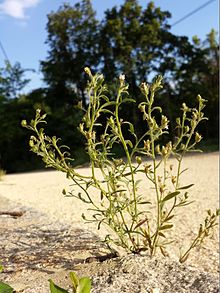Small toadflax
| Small toadflax | ||||||||||||
|---|---|---|---|---|---|---|---|---|---|---|---|---|

Lesser toadflax ( Chaenorhinum minus ), illustration |
||||||||||||
| Systematics | ||||||||||||
|
||||||||||||
| Scientific name | ||||||||||||
| Chaenorhinum minus | ||||||||||||
| ( L. ) Long |
The small toadflax ( Chaenorhinum minus ), also known as the small orant and common gaping mouth , is a species of plant from the plantain family (Plantaginaceae).
description
The small toadflax is an annual herbaceous plant and reaches a stature height of usually 10 to 25 (5 to 40) cm. The upright stalk is round and usually sparsely branched from below. Stems and leaves are hairy protruding, often with glandular hairs. The constantly against the bottom of the stem, in the remaining area alternate arranged leaves are short stalks to sitting. The simple, somewhat fleshy leaf blade is linear-lanceolate with a length of 5 to 35 mm and a width of about 4 mm.
The flowering period extends from June to September. The flowers stand individually in the axils of bracts. The flower stalk has a length of 3 to 25 mm. The hermaphrodite flowers are zygomorphic and five-fold with a double flower envelope . The sepals are 2 to 5 mm long. The light purple petals form a “lion's mouth” crown, i. H. the lower lip has a bulge that blocks the flower entrance. The upper lip consists of two, the lower lip of three corolla lobes. The rear part of the flower forms an almost straight, short, conical, trimmed spur . The flower is 5 to 12 mm long, almost half of which is on the spur. It is white-purple, often tinged with purple on the outside. The lower lip bulge and "palate" inside the flower is light yellow.
The unevenly egg-shaped capsule fruit is designed as a lid capsule fruit with a shallow transverse groove, with uneven compartments that open with tooth-like flaps. The seeds are spread by the wind.
Self-pollination is very common in Chaenorhinum minus . For this reason, many clans have emerged that differ somewhat from one another.
The chromosome number of the species is 2n = 14.
Occurrence
The main focus of the distribution of the small toadflax is southern and central Europe. However, it also occurs as far as Sweden, Finland and the British Isles. It is occasionally found in other countries and in North America as a result of carryover. In the German-speaking area it is widespread in the south and mostly to be found frequently, in the north it is scattered.
The small toadflax prefers alkaline and calcareous, sandy or stony soils. It occurs as field weeds, but is now mostly found on roadsides, on railways and in abandoned quarries. The toadflax is primarily a character species of the class Thlaspietea rotundifolii, especially of the association Stipion calamagrostis, secondarily it occurs in societies of the associations Sisymbrion, Fumario-Euphorbion, Caucalidion lappulae or Salsolion. In the Allgäu Alps, it rises in the Kleiner Walsertal on the roadside near Hirschegg -Wäldele up to 1170 m above sea level.
Systematics and names
The genus Chaenorhinum was formerly the family of Figworts classified (Scrophulariaceae). Genetic studies have shown that it belongs to the plantain family (Plantaginaceae).
This species was in 1753 under the name Antirrhinum minus by Linnaeus in Species Plantarum , 2, p.617 first published . It was placed in the genus Chaenorhinum in 1870 by Johan Martin Christian Lange in Prodromus Florae Hispanicae , 2, pp. 577-578 , where it was written "Chaenorrhinum". Further synonyms for Chaenorhinum minus (L.) Lange are: Chaenorhinum viscidum Simonk. , Linaria minor (L.) Desf. and Microrrhinum minus (L.) Fourr.
There are four subspecies of Chaenorhinum minus :
- Chaenorhinum minus subsp. anatolicum P.H.Davis (Syn .: Microrrhinum minus subsp. anatolicum (PH Davis) NN ): It occurs in the Aegean Sea.
- Chaenorhinum minus subsp. minus :
- Chaenorhinum minus subsp. idaeum (Rech. fil.) R.Fern. (Syn .: Microrrhinum minus subsp. Idaeum (Rech. F.) NN ): It occurs on Crete.
- Chaenorhinum minus subsp. pseudorubrifolium (Gamisans) NN (Syn .: Microrrhinum minus subsp. pseudorubrifolium (Gamisans) NN ): It occurs in Corsica.
Other names for the small toadflax are or were also small fleabane and dog skull .
photos
swell
literature
- Oskar Sebald, Siegmund Seybold, Georg Philippi, Arno Wörz (eds.): The fern and flowering plants of Baden-Württemberg . tape 5 : Special part (Spermatophyta, subclass Asteridae): Buddlejaceae to Caprifoliaceae . Eugen Ulmer, Stuttgart (Hohenheim) 1996, ISBN 3-8001-3342-3 .
- Dietmar Aichele, Heinz-Werner Schwegler: The flowering plants of Central Europe , Volume 4, Kosmos Verlag, ISBN 3-440-08048-X .
- K. Lauber, G. Wagner: Flora Helvetica CD-ROM V. 1.0. Verlag Paul Haupt, ISBN 3-258-05407-X .
- Small toadflax. In: FloraWeb.de. (Section description)
Individual evidence
- ↑ a b Erich Oberdorfer : Plant-sociological excursion flora for Germany and neighboring areas. 8th edition. Stuttgart, Verlag Eugen Ulmer, 2001, p. 831, ISBN 3-8001-3131-5 .
- ↑ Distribution map of the northern hemisphere
- ↑ Distribution map Germany
- ↑ Erhard Dörr, Wolfgang Lippert : Flora of the Allgäu and its surroundings. Volume 2, IHW, Eching 2004, ISBN 3-930167-61-1 .
- ↑ Entry in Tropicos
- ^ Georg August Pritzel , Carl Jessen : The German folk names of plants. New contribution to the German linguistic treasure. Philipp Cohen, Hannover 1882, page 35, online.
Web links
- Chaenorhinum minus (L.) Lange, Kleiner Orant. In: FloraWeb.de.
- Small toadflax . In: BiolFlor, the database of biological-ecological characteristics of the flora of Germany.
- Chaenorrhinum minus (L.) Lange s. st. In: Info Flora , the national data and information center for Swiss flora . Retrieved March 5, 2016.
- Distribution in the northern hemisphere according to Hultén
- Thomas Meyer: Orant data sheet with identification key and photos at Flora-de: Flora von Deutschland (old name of the website: Flowers in Swabia )
- Gewöhnlicher Klaffmund / Kleiner Orant / Kleines Toadflax Microrrhinum minus (s. Str) (Chaenarrhinum minus subsp. Minus) at Botanik im Bild / Flora von Österreich , 2006.




